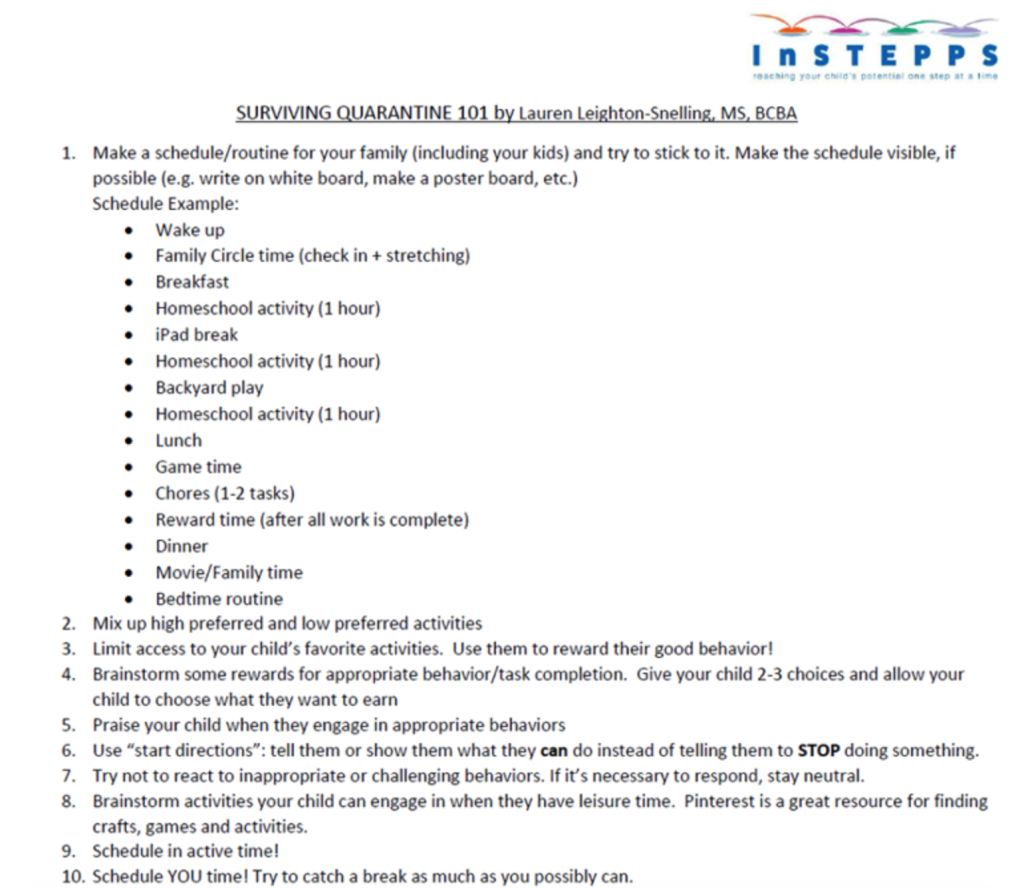Maintaining Skills For Your Autistic Child During Home Isolation
a guest blog post by Molly Reilly, BCBA

We are living in an extremely unique situation and it is important to acknowledge that you will be times when you give in, you are human. Now is probably not the best time to teach new skills; rather, it is a perfect time to work on strengthening skills that your child has mastered. If possible ask your child’s teacher or therapist for a list of mastered skills for you to work on while at home. As a bonus this will help your child generalize skills to new people and settings.
What kind of skills? Here are some examples:
Functional Communication
This is the ability to communicate an individual’s wants and needs is an essential life skill. While now is not the time to intensely teach new skills, it is always a good idea to encourage your child to communicate their basic wants and needs in whatever manner is most appropriate for them(e.g. verbal speech for verbal children, sign language for preverbal children with strong imitation skills, Pecs for preverbal children with strong visual discrimination skills, etc.). Functional Communication Training (FCT) is a fundamental positive behavior support strategy in which an individual is taught an appropriate communicative behavior to replace an undesirable behavior. For more information on FCT including implementation steps please see Afirm’s FCT module.
Coping Skills
Coping skills are also a fundamental life skill that can be particularly helpful in times of uncertainty and anxiety. Examples of potential coping skills include deep breathing, listening to music, taking a walk, etc. To further promote coping skills consider creating a calm space in the house where anyone can go and take some time to relax may also be helpful. The area could include calming items such as soft blankets, sensory balls, pillows, sensory bottles, stuffed animals etc. UNC has developed a wonderful toolkit that contains a section on promoting calming and coping skills including visual supports and recommended mindfulness apps.
But how?
Use Reinforcement
Uncertainty is hard for everyone – reinforce everything, especially flexibility! Positive praise is particularly important for children that thrive on attention. Be sure to keep their tank full by providing lots of praise throughout the day by aiming to provide five positive statements to every negative statement. Emphasize all of the things your child does right! (e.g. playing cooperatively next to a sibling, trying a vegetable, taking turns on the ipad, asking for help, throwing away garbage, etc.). In addition to providing ample praise using simple and positive language can also be helpful. Rather than saying “I can’t play bingo with you right now” try saying “I can play a game with you later today but now you can play legos”. For children motivated by activities or tangible items try sure to provide them with access to a desired activity/item following instances of desired behavior.
But use them wisely
Try not to allow free access to reinforcers by laying out each of your child’s favorite toys at the beginning of the day in hopes they will entertain themselves so that you can get things done. Rather, present desired items or activities individually and rotate them, this is especially important for highly desired items such as technology. The following strategies may help differentiate academic screen time and leisure screen time:
• Different devices (e.g. laptop for academic tasks and tablet for leisure)
• Different locations (academic screen time in kitchen and leisure screen time in living room)
• Different cases (academic screen time in blue case and leisure screen time in green case)
You have a lot of responsibilities (e.g., plan meals, do laundry, clean, teach, parent, and for some people telecommute) so be sure to schedule in special 1:1 time with each of your kids. Truly make this their time and follow their lead. Try not to direct the activity; rather, notice what your child enjoys and simply join. Even if this means sitting next to them while they play with their tablet that is okay! Make comments and praise if appropriate (whoa! Look at that car!) simply rub their back.
Safety First
To ensure that everyone in your house is safe it may be a good idea to take a careful look around your home and make modifications that reduce the risk of injury. Examples include putting potentially poisonous materials such as keeping medicine and cleaning solutions in areas only accessible by responsible adults, removing wall hangings, and rearranging furniture. In the event that challenging behaviors do occur, removing yourself from the situation (as long as your child is safe) and having a basic safety plan may be a good idea but consult with your child’s BCBA for specific recommendations.
Pick your battles
Identify times that can be problematic (e.g. at the end of the day when everyone is tired) and give yourself permission to not be perfect and allow access to highly preferred items or activities such as screen time. Also avoid giving a direction unless you are willing and able to carry through. If you instruct your child to hang their coat up on after they throw it on the floor, be sure you are willing to (and have enough energy) carry through with the instruction. As I stated above, give yourself permission to not be perfect! Parents of typically developing kids who find themselves trying to homeschool openly acknowledge the extreme difficulty. #homeschool is a trending hashtag on social media and some of the posts are hilarious

INSTEPPS is a company in CA that utilizes NDBIs and has some great resources on their facebook page including:


